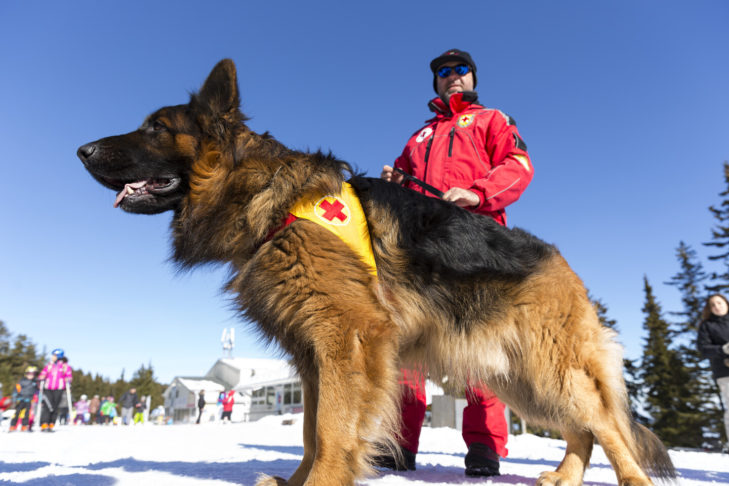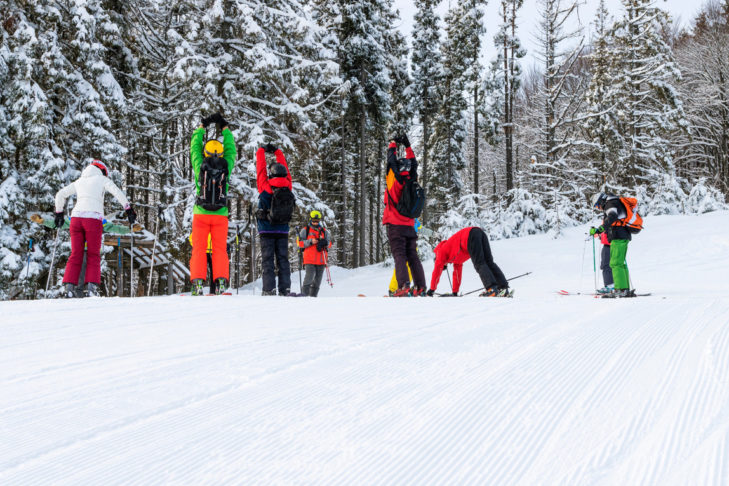Skiing gets safer with every season. The accident statistics prove it: Fewer and fewer winter sports enthusiasts are getting injured every year. This means greater protection through equipment and better prepared as well as more considerate skiers. Nevertheless, as with any sport, there is of course a certain risk of injury when skiing. SnowTrex takes a look at the six most common ski injuries, their causes and how best to avoid them.
The most common injury spots in skiing
Knee injuries
It is the knees that suffer the most from skiing. This is because both women and men injure themselves here most often. However, the differences are great. A good 44 percent of all women suffered a skiing injury to the knee in the 2016/2017 winter season, while it was only 23 percent among male skiers. This means that knee injuries are, on average, the most common injury in skiing.
Shoulder injuries
After knee injuries, shoulder injuries are particularly common among men (24.5 per cent). A good 20 percent of all skiers are injured in this area, followed by head injuries (eleven percent).
Torso injuries
The torso is another area where many winter sports enthusiasts get injured. More than nine percent suffer injuries in this area. This makes it the fourth most common area of injury in skiing.
Hip, thigh and lower leg injuries
In fifth place on the list of the most common skiing injuries are hips and thighs, and in sixth place on the injury scale are lower legs.
Overestimating yourself: many injuries could be avoided
As you can see from these particularly common injuries, falls are the main causes of injuries while skiing. 84 percent of all skiing injuries are self-inflicted and occur after falls. Only six percent of skiing accidents occur after a collision with other skiers.
On the one hand, this means that the slopes themselves are safe and modern ski equipment prevents many more serious accidents. On the other hand, it also shows that the falls are mostly due to one’s own fault and can therefore also be avoided.
For example, more than half of all skiers get injured in the first two days of their ski holiday. In addition to the unaccustomed altitude, the special weather conditions also lead to more frequent falls during this time. In addition, the body is often not prepared for the upcoming exertion due to a lack of appropriate physical preparation for winter sports, and the lack of skiing routine also makes itself felt in falls.
This can be avoided by taking things slowly during the first few days on the slopes. Which means that you should take enough breaks, ski easier slopes at the beginning and end the ski day in the early afternoon. Under these conditions, the body can get used to both the altitude and the sporting demands without causing injuries through carelessness or lack of training.
If you notice after the first few runs that you feel insecure on skis, you can also take a skiing course. This allows you to both refresh and deepen your own knowledge, and you will then be more confident on the slopes.
In general, one’s own overestimation of one’s own abilities and the resulting riskier skiing style is also another reason for skiing injuries. In addition, both the wide carving skis and the well-prepared pistes give a strong feeling of safety, which can tempt skiers into risky skiing behavior.
Here too, caution is better than injury and thus the end of the skiing holiday. Those who slowly increase the speed and difficulty of the slopes will not only have just as much fun on the descent, but will also have a much lower risk of injury.
Inattention is some of the most common causes of falls and collisions while skiing, even beyond the first few days of the ski holiday. Of course, you can’t always avoid a collision, but if you go onto the slopes well rested and well-rested, are physically fit and thus ski more attentively, you can avoid many such accidents.
Warming up before the first descent is not to be underestimated, in order to get the circulation going and warm up the muscles. This reduces the risk of injury on the slopes.
While driving, you should always take breaks and drink enough – preferably water and no alcohol. Snacks will also help you to regain your strength and concentrate on your driving. This also leads to far fewer falls and thus fewer injuries.
This equipment helps prevent injuries
In addition to anticipatory and attentive skiing, equipment can also help enormously to minimize the risk of injury when skiing.
Young male skiers in particular rely on back protectors when doing winter sports. These can at least absorb falls in the back and torso area, even if the protectors do not mean that you can or should therefore ski faster and more riskily.
Wrist protectors also offer good protection in case of falls. But the proven best protection in terms of equipment is the ski helmet – for most people it is already standard equipment. A helmet protects against serious head injuries in the event of a fall, and should therefore be important to every winter sports enthusiast.
Even though skiing accidents can never be completely avoided, many of the top injuries after falls can be prevented by attentive driving, caution and good protective equipment.
FAQs about skiing injuries
Is skiing a risky sport?
As with any sport, there is a risk of injury in skiing. Nevertheless, the number of injured winter sportsmen and women is at a historically low level and the injuries are also no longer as serious. The greatest dangers in skiing are overestimating oneself, skiing too riskily and not being attentive enough.
What are the most common ski injuries?
The top six areas of injury when skiing are the knees, shoulders, head, torso, hips with thighs and lower legs.
What are the main causes of accidents?
Self-inflicted falls are by far the most common cause of these skiing injuries. Skiers often start their holidays too ambitiously and ski too fast, too riskily. They often don’t take the time to get their bodies used to the sport, the altitude and the weather conditions.
How can you avoid injuries while skiing?
The better prepared you are and the more attentively you ski, the safer you will be on the slopes. Therefore, you should always go onto the slopes well rested, warm up beforehand, take enough breaks and drink plenty of fluids, as well as slowly increase the speed and difficulty of the descents.
Do I have to be a competitive skier to ski safely?
No. However, skiing requires a certain general physical fitness and condition. It is therefore advisable to do moderate but regular sport outside the ski season. It is not the intensity of the sport that is important, just the regularity of exercise.
What happens if you witness a fall?
Every winter sportsman is obliged to help in the event of an accident. First you secure the accident site, check the state of the injury, call for help and then give first aid to the injured person.
What safety equipment protects against ski injuries?
A ski helmet offers the most and most important protection. But protectors on the back and wrists can also be a good additional protection, if you do not allow yourself to be tempted into riskier skiing behaviour.








